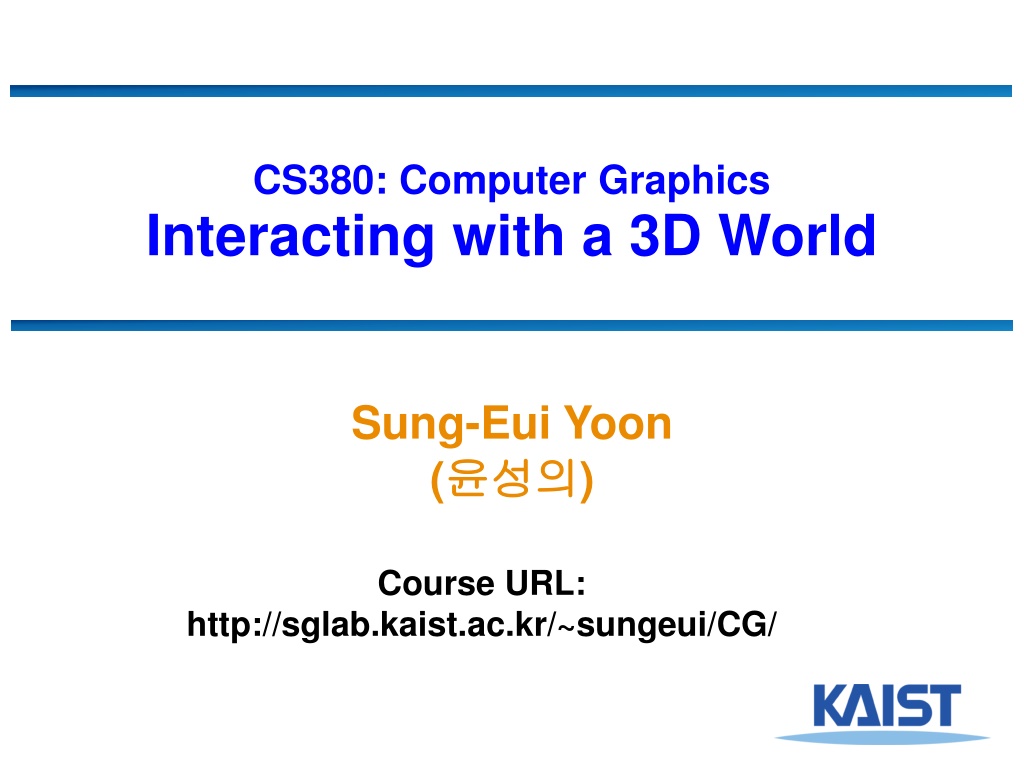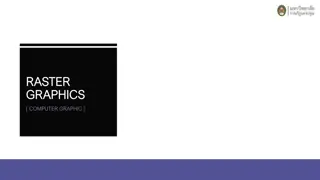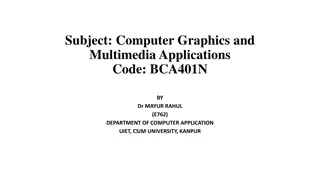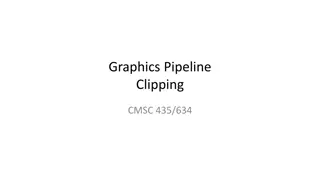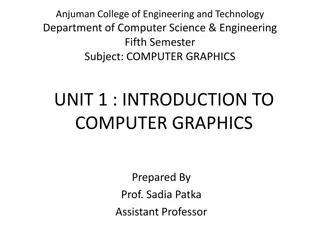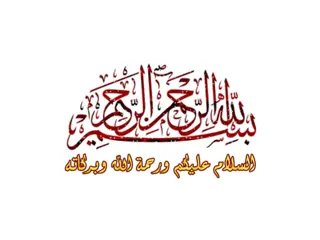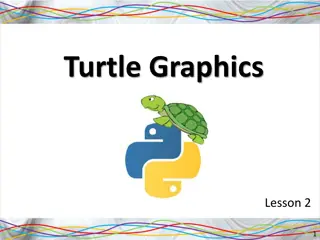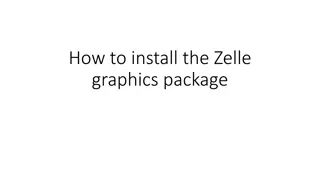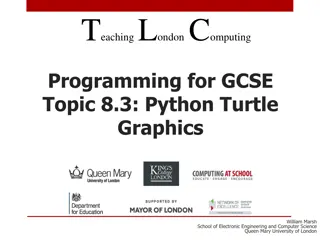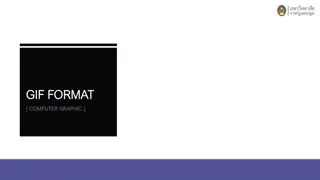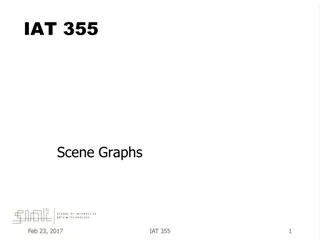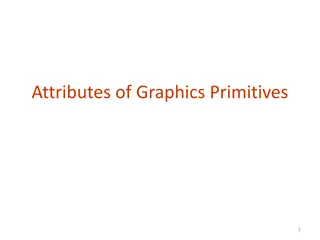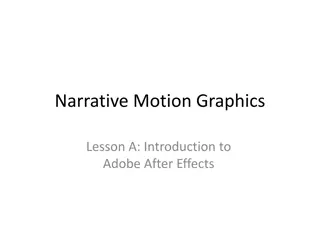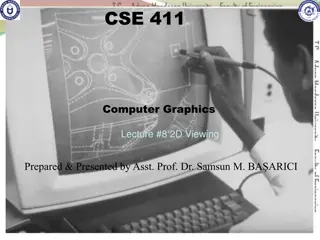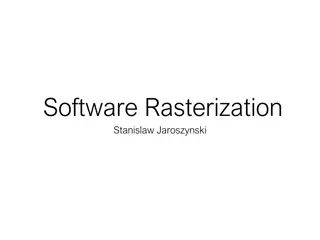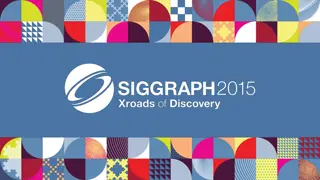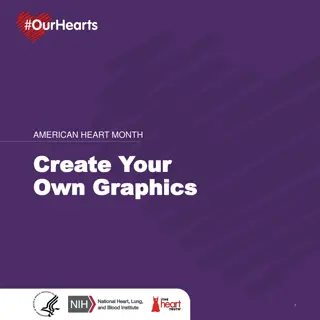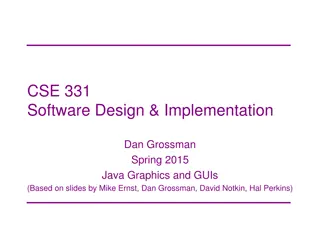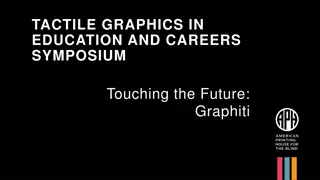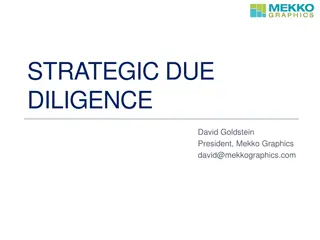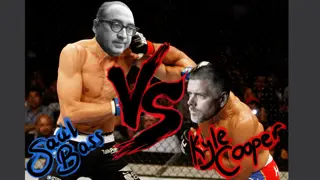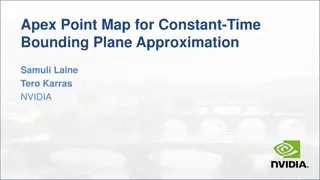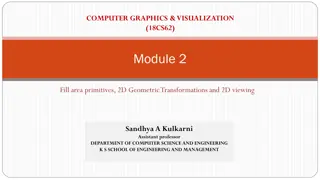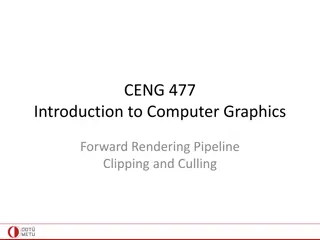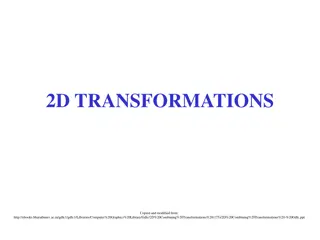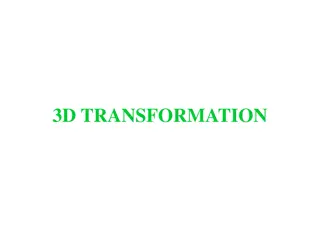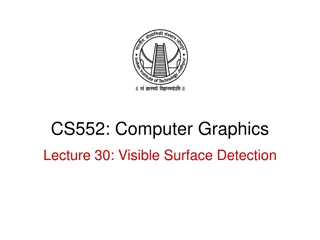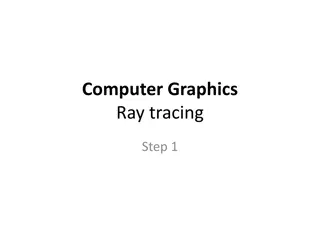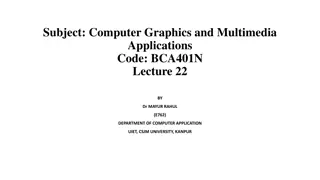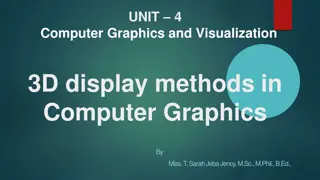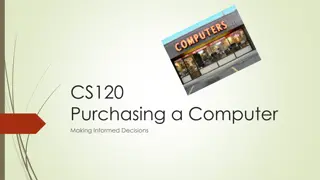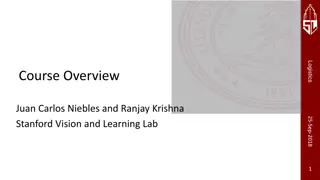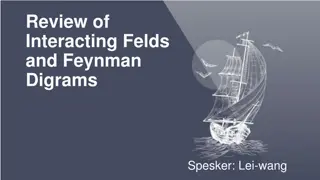Computer Graphics: Interacting with a 3D World Course Overview
Explore the world of computer graphics through Sung-Eui Yoon's CS380 course. Learn about mesh representation, selection methods, virtual interfaces, modeling hierarchies, primitive 3D objects, and more. Dive into the specifics of specifying 3D objects, simple planes, face representation, vertex specifications, normal vectors, and drawing faces in OpenGL. Gain insights into creating immersive visual experiences in a 3D environment.
Download Presentation

Please find below an Image/Link to download the presentation.
The content on the website is provided AS IS for your information and personal use only. It may not be sold, licensed, or shared on other websites without obtaining consent from the author. Download presentation by click this link. If you encounter any issues during the download, it is possible that the publisher has removed the file from their server.
E N D
Presentation Transcript
CS380: Computer Graphics Interacting with a 3D World Sung-Eui Yoon ( ) Course URL: http://sglab.kaist.ac.kr/~sungeui/CG/
Announcement Mid-term exam 4:00pm ~ 5:40pm, Apr-22 (Tue.) 2
Class Objectives Read a mesh representation Understand a selection method and a virtual-trackball interface Understand the modeling hierarchy 3
Primitive 3D How do we specify 3D objects? Simple mathematical functions, z = f(x,y) Parametric functions, (x(u,v), y(u,v), z(u,v)) Implicit functions, f(x,y,z) = 0 Build up from simple primitives Point nothing really to see Lines nearly see through Planes a surface 4
Simple Planes Surfaces modeled as connected planar facets N (>3) vertices, each with 3 coordinates Minimally a triangle 5
Specifying a Face Face or facet Face [v0.x, v0.y, v0.z] [v1.x, v1.y, v1.z] [vN.x, vN.y, vN.z] Sharing vertices via indirection Vertex[0] = [v0.x, v0.y, v0.z] Vertex[1] = [v1.x, v1.y, v1.z] Vertex[2] = [v2.x, v2.y, v2.z] v3 v0 : v2 v1 Vertex[N] = [vN.x, vN.y, vN.z] Face v0, v1, v2, vN 6
Vertex Specification Where Geometric coordinates [x, y, z] Attributes Color values [r, g, b] Texture Coordinates [u, v] Orientation Inside vs. Outside Encoded implicitly in ordering Geometry nearby Often we d like to fake a more complex shape than our true faceted (piecewise-planar) model Required for lighting and shading in OpenGL 7
Normal Vector Often called normal, [nx, ny, nz] Normal to a surface is a vector perpendicular to the surface Will be used in illumination Normalized: 2 y x n n n [ n , n , ] = n x y z n 2 2 z + + 8
Drawing Faces in OpenGL glBegin(GL_POLYGON); foreach (Vertex v in Face) { glColor4d(v.red, v.green, v.blue, v.alpha); glNormal3d(v.norm.x, v.norm.y, v.norm.z); glTexCoord2d(v.texture.u, v.texture.v); glVertex3d(v.x, v.y, v.z); } glEnd(); Heavy-weight model Attributes specified for every vertex Redundant Vertex positions often shared by at least 3 faces Vertex attributes are often face attributes (e.g. face normal) 9
Decoupling Vertex and Face Attributes via Indirection Works for many cases Used with vertex array or vertex buffer objects in OpenGL Exceptions: Regions where the surface changes materials Regions of high curvature (a crease) 10
3D File Formats MAX Studio Max DXF AutoCAD Supports 2-D and 3-D; binary 3DS 3D studio Flexible; binary VRML Virtual reality modeling language ASCII Human readable (and writeable) OBJ Wavefront OBJ format ASCII Extremely simple Widely supported 11
OBJ File Tokens File tokens are listed below # some text Rest of line is a comment v float float float A single vertex s geometric position in space vn float float float A normal vt float float A texture coordinate 12
OBJ Face Varieties f int int int ... or f int/int int/int int/int . . . or f int/int/int int/int/int int/int/int texture, & normal) (vertex only) (vertex & texture) (vertex, The arguments are 1-based indices into the arrays Vertex positions Texture coordinates Normals, respectively 13
OBJ Example Vertices followed by faces Faces reference previous vertices by integer index 1-based # A simple cube v 1 1 1 v 1 1 -1 v 1 -1 1 v 1 -1 -1 v -1 1 1 v -1 1 -1 v -1 -1 1 v -1 -1 -1 f 1 3 4 f 5 6 8 f 1 2 6 f 3 7 8 f 1 5 7 f 2 4 8 14
OBJ Sources Avalon Viewpoint (http://avalon.viewpoint.com/) old standards 3D Caf (http://www.3dcafe.com/asp/meshes.asp) Nice thumbnail index Others Most modeling programs will export .OBJ files Most rendering packages will read in .OBJ files 15
Picking and Selection Basic idea: Identify objects selected by the user Click-selection: select one object at a time Sweep-selection: select objects within a bounding rectangle Demo (click h) 16
Picking and Selection Several ways to implement selection: Find screen space bounding boxes contained in pick region Compute a pick ray and ray trace to find intersections OpenGL selection buffers Render to back buffer using colors that encode object IDs and return ID under pick point 17
Selection with the Back Buffer Selects only objects that are visible Render objects to back buffer with color that encodes ID Use glReadPixels() to read the pixel at the pick point Back buffer is never seen 18
An Example of Reading the Back Buffer void onMouseButton(int button, int state, int x, int y) { ... if (button == GLUT_LEFT_BUTTON && state == GLUT_DOWN) { printf( "Left mouse click at (%d, %d)\n", x, y ); selectMode = 1; display(); glReadBuffer(GL_BACK); unsigned char pixel[3]; glReadPixels(x, y, 1, 1, GL_RGB, GL_UNSIGNED_BYTE, pixel); printf( "pixel = %d\n", unmunge(pixel[0],pixel[1],pixel[2])); selectMode = 0; } } 19
Buffer Operations in OpenGL Still supported in OpenGL 4.3 glReadBuffer (mode) GL_FRONT, GL_BACK, etc. glReadPixels(x, y, w, h, pixel_format, data_type, * buffers) Pixel_format: GL_RGB, GL_RGBA, GL_RED, etc. Data_type: GL_UNSIGNED_BYTE, GL_FLOAT, etc. Other related APIs glDrawPixels 20
Interaction Paradigms Can move objects or camera Object moving is most intuitive if the object sticks to the mouse while dragging 21
Interaction Paradigms Move w.r.t. to camera frame Pan move in plane perpendicular to view direction Dolly move along the view direction Zoom - looks like dolly: objects get bigger, but position remains fixed Rotate up/down controls elevation angle left/right controls azimuthal angle Roll spin about the view direction Trackball can combine rotate and roll 22
Interaction Paradigms Move w.r.t to modeling (or world) frame Maya combines both Presents a frame where you can drag w.r.t the world axes Dragging origin moves w.r.t. to camera frame 23
Interaction - Trackball A common UI for manipulating objects 2 degree of freedom device Differential behavior provides a intuitive rotation specification Trackball demo Trackball demo 24
A Virtual Trackball Imagine the viewport as floating above, and just touching an actual trackball You receive the coordinates in screen space of the MouseDown() and MouseMove() events What is the axis of rotation? What is the angle of rotation? 25
Computing the Rotation a a Construct a vector from the center of rotation of the virtual trackball to the point of the MouseDown() event Construct a 2nd vector from the center of rotation for a given MouseMove() event a = b 1 angle cos (a b) = b b b = a Normalize , and , and then compute a a = axis Rotate(angle, b R = Then find the and construct ) axis axis a a b axis 26
Transformation Hierarchies Many models are composed of independent moving parts Each part defined in its own coordinate system Compose transforms to position and orient the model parts A simple One-chain example 27 http://www.imanishi.com
Code Example (Take One) public void Draw() { glClear(GL_COLOR_BUFFER_BIT | GL_DEPTH_BUFFER_BIT); glLoadIdentity(); gluLookat(0, 0,-60, 0,0,0, 0,1,0); // world-to-camera transform glColor3d(0,0,1); glRotated(-90, 1, 0, 0); // base-to-world transform Draw(Lamp.BASE); Draw(Lamp.BODY); Draw(Lamp.NECK); Draw(Lamp.HEAD); glFlush(); } 28
Code Example (Take Two) public void Draw() { glClear(GL_COLOR_BUFFER_BIT | GL_DEPTH_BUFFER_BIT); glLoadIdentity(); glTranslated(0.0, 0.0, -60.0); // world-to-view transform glColor3d(0,0,1); glRotated(-90, 1, 0, 0); Draw(Lamp.BASE); glTranslated(0,0,2.5); Draw(Lamp.BODY); glTranslated(12,0,0); Draw(Lamp.NECK); glTranslated(12,0,0); Draw(Lamp.HEAD); glFlush(); } // base-to-world transform // body-to-base transform // neck-to-body transform // head-to-neck transform 29
Code Example (Take Three) public void Draw() { glClear(GL_COLOR_BUFFER_BIT | GL_DEPTH_BUFFER_BIT); glLoadIdentity(); glTranslated(0.0, -12.0, -60.0); // world-to-view transform glColor3d(0,0,1); glRotated(-90, 1, 0, 0); Draw(Lamp.BASE); glTranslated(0,0,2.5); glRotated(-30, 0, 1, 0); Draw(Lamp.BODY); glTranslated(12,0,0); // neck-to-body transform glRotated(-115, 0, 1, 0); Draw(Lamp.NECK); glTranslated(12,0,0); // head-to-neck transform glRotated(180, 1, 0, 0);// rotate head at neck pivot Draw(Lamp.HEAD); glFlush(); } // base-to-world transform // body-to-base transform // rotate body at base pivot // rotate neck at body pivot 30
Class Objectives were: Read a mesh representation Understand a selection method and a virtual-trackball interface Understand the modeling hierarchy 31
Program Assignment 4 Use the previous skeleton codes 32
Reading Assignment Read Chapter A Full Graphics Pipeline 33
Figs 34
?? ?? ??: transform from the base to the world ??: transform from the part to the base 35
